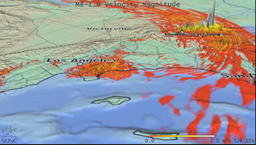M8
From SCECpedia
Jump to navigationJump to searchSCEC M8 Simulation
The SCEC M8 Simulation involved a very large dynamic rupture, run on NICS Kraken in March, 2010, and a very large and earthquake wave propagation simulation, performed on NICS Jaguar in April 2010. The M8 simulation represented the largest earthquake wave propagation simulation in several categories including:
M8 can be described as the largest earthquake wave propagation simulation for following reasons:
- The simulation computational scale for the SAF area with a combined outer/inner scale of 10 ^ 4.3 (810km/40m)
- FLOPS, no other seismic code achieved more than 100Tflop/s so far.
- processor cores used, no other seismic apps use so many cores
- scalability, nearly perfectly up to 223k cores
- grid points, 435billion. We are not aware of any simulations at this size.
The M8 Project is lead by Yifeng Cui, Kim Olsen, and Thomas H. Jordan.
SCEC and CME-related Web Sites
- PetaSHA3 Project
- SCEC/CME Project Page
- Public CME Website
- Public SCEC Wiki
- SCEC Web Site
- CSEP
- SCEC M8
- CME Movies and Animations
- CVM-Toolkit
- SCEC Websims Data Management Site
- SCEC CSEP Testing Center
SCEC Computer Science Collaborative Organizations and Resource Providers
- SDSC
- SDSC HPGeoC
- SDSC Visualization Services
- Scientific Workflows at USC/ISI
- Fault Tolerant Computing at CSM
- USC HPCC
- PSC
- NICS
- NCCS
- TACC
- NCSA
- Blue Waters
- Open Science Grid
CME-related 2010 SCEC Annual Meeting Posters:
